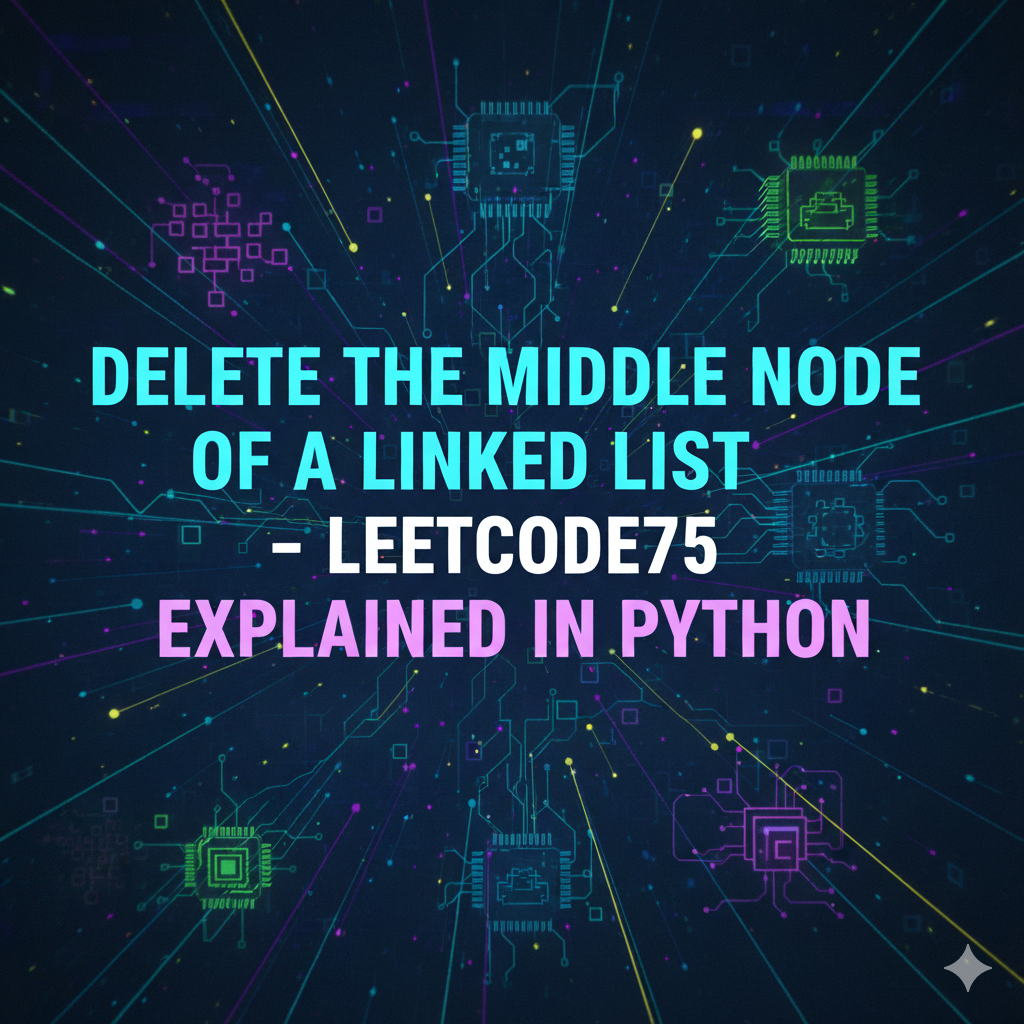Linked lists are one of the most fundamental data structures in computer science and form the backbone of many real-world systems. The Delete the Middle Node of a Linked List problem (LeetCode75) is an excellent exercise to practice two-pointer techniques, linked list traversal and node manipulation. It is not only common in coding interviews but also essential for understanding how linked lists operate at a deeper level.

In this blog, we’ll break down the problem, analyze examples and provide a complete Python solution with step-by-step explanations. By the end, you’ll gain confidence in handling linked list problems and be better prepared for technical interviews.
Problem Statement
You are given the head of a linked list. Your task is to delete the middle node of the linked list and return the head of the modified list.
- If the list has n nodes, the middle node is defined as the ⌊n / 2⌋-th node (0-indexed).
- If the list has only one node, return
None.
Understanding the Problem
The challenge lies in locating the middle node without explicitly counting all nodes in advance. While one approach is to traverse the list twice (once to count, once to delete), a more efficient approach is to use the fast and slow pointer method.
Here’s how it works:
- Use a slow pointer that moves one step at a time.
- Use a fast pointer that moves two steps at a time.
- When the fast pointer reaches the end, the slow pointer will be at the middle node.
- Keep track of the node before the slow pointer to perform deletion.
Examples
Example 1
Input: head = [1, 3, 4, 7, 1, 2, 6]
Output: [1, 3, 4, 1, 2, 6]
Explanation: The middle node is 7. After deleting, the list becomes 1 → 3 → 4 → 1 → 2 → 6.
Example 2
Input: head = [1, 2, 3, 4]
Output: [1, 2, 4]
Explanation: The middle node is 3. After deletion, we have 1 → 2 → 4.
Example 3
Input: head = [2, 1]
Output: [2]
Explanation: The middle node is 1. Only 2 remains.
Complete Python Solution
from typing import Optional
class ListNode:
def __init__(self, val=0, next=None):
self.val = val
self.next = next
class Solution:
def deleteMiddle(self, head: Optional[ListNode]) -> Optional[ListNode]:
if not head or not head.next:
return None
slow = head
fast = head
prev = None
while fast and fast.next:
prev = slow
slow = slow.next
fast = fast.next.next
if prev:
prev.next = slow.next
else:
head = slow.next
return head
Step-by-Step Explanation
Step 1: Handle Edge Case
If the list has only one node, deleting it means returning None.
if not head or not head.next:
return None
Step 2: Initialize Pointers
We set both slow and fast pointers at the head. We also keep prev to track the node before slow.
slow = head
fast = head
prev = None
Step 3: Move Pointers
- Move
slowone step. - Move
fasttwo steps.
Whenfastreaches the end,slowwill be at the middle.
while fast and fast.next:
prev = slow
slow = slow.next
fast = fast.next.next
Step 4: Delete the Middle Node
Point prev.next to slow.next, effectively removing slow from the list.
if prev:
prev.next = slow.next
else:
head = slow.next
Step 5: Return Modified List
Finally, return the updated head of the linked list.
return head
Time and Space Complexity
- Time Complexity:
O(n)→ Each node is visited once. - Space Complexity:
O(1)→ We only use pointers, no extra memory.
Edge Cases
- Single Node List: Input
[5]→ OutputNone. - Two Node List: Input
[1, 2]→ Output[1]. - Even Length List: Input
[1, 2, 3, 4]→ Output[1, 2, 4]. - Odd Length List: Input
[1, 3, 4, 7, 1, 2, 6]→ Output[1, 3, 4, 1, 2, 6].
Real-World Applications
Deleting a middle element in a linked list may sound simple but it mimics many real-world scenarios:
- Memory management systems where linked lists track allocated blocks and nodes must be deleted efficiently.
- Social media feeds where posts are dynamically removed while maintaining the sequence.
- Task scheduling systems that reassign jobs when a middle task is canceled.
- Data stream processing where mid-sequence data points are discarded without disrupting flow.
Conclusion
The Delete the Middle Node of a Linked List problem (LeetCode75) is a great way to practice two-pointer techniques and deepen your understanding of linked list operations. By using a fast and slow pointer, we efficiently find and delete the middle node in a single traversal.
Mastering this challenge builds confidence in manipulating linked lists, a skill that’s frequently tested in coding interviews and crucial in real-world systems like memory allocation, data streams and task scheduling.
Related Reads
- Dota2 Senate in Python – LeetCode75 Explained
- Number of Recent Calls (LeetCode75) – Python Solution Explained
- Decode String in Python – Step-by-Step LeetCode75 Solution
- 500 + AI, Machine Learning, Deep Learning, Computer Vision and NLP Projects with Code
- SkyPilot: Simplifying AI Workload Management Across Any Infrastructure

4 thoughts on “Delete the Middle Node of a Linked List – LeetCode75 Explained in Python”